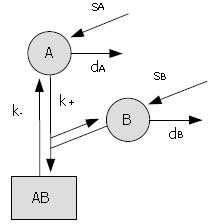Copyright
©2007 Baishideng Publishing Group Co.
World J Gastroenterol. Mar 7, 2007; 13(9): 1399-1407
Published online Mar 7, 2007. doi: 10.3748/wjg.v13.i9.1399
Published online Mar 7, 2007. doi: 10.3748/wjg.v13.i9.1399
Figure 3 Example of a simple kinetic model.
The proteins A and B undergo normal protein turnover (s = synthesis rates, d = degradation rates) and associate to form a protein complex, AB (k+ = assembly rate, k- = dissociation rate). The behaviour of the system is captured by the following system of ordinary differential equations: d [A]/dt = sA - k+ [A] [B] + k- [AB] - dA [A]; d [B]/dt = sB - k+ [A] [B] + k- [AB] - dB [B]; d [AB]/dt = k+ [A] [B] - k- [AB]; with initial conditions [A] (0) = A0, [B] (0) = B0 and [AB] (0) = 0. It can be shown that, eventually, the components stabilise at levels given by: [A] = sA/dA; [B] = sB/dB, and [AB] = sA sB/(dA dB K), with K = k-/k+ the dissociation constant.
- Citation: van Leeuwen IM, Edwards CM, Ilyas M, Byrne HM. Towards a multiscale model of colorectal cancer. World J Gastroenterol 2007; 13(9): 1399-1407
- URL: https://www.wjgnet.com/1007-9327/full/v13/i9/1399.htm
- DOI: https://dx.doi.org/10.3748/wjg.v13.i9.1399









